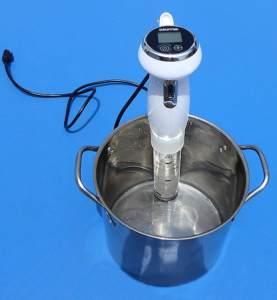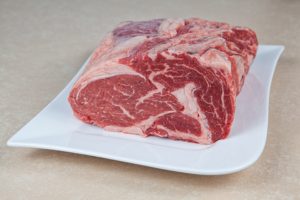A trendy cooking method, “sous vide” translates from French into “under vacuum.” This isn’t very helpful, though, when it comes to picturing what’s going on. When chefs cook “sous vide,” they vacuum-seal an ingredient into a plastic bag and submerge it in heated water. After the set amount of time, the food becomes fully-cooked. Is it magic? It’s science.
Sous vide’s beginnings
In 1799, Sir Benjamin Thompson conducted an experiment. He owned a machine used for drying out potatoes, and he wanted to see if he could cook meat in it. After sticking a leg of mutton in and waiting for 3 hours, he got bored. He went to bed, leaving the machine for the maids to clean up. They didn’t notice it until the morning, however, and when they took out the mutton, it had cooked! Thompson tasted it, and to his delight, it was perfect. Despite his success, he never investigated the science further.
150 years later, George Pralus performed an experiment of his own. As a chef in France, he worked with foie gras a lot, but during the cooking process, it lost 50% of its weight. To prevent this, Pralus tried wrapping the foie gras in plastic first. Only 5% of the weight was lost, so Pralus continued to wrap food in plastic before submerging it in water. Bruno Goussault, a chef and food scientist, built on this method by significantly lowering the temperature of the water the sealed food went into. He went on to make sous-vide meals for airplanes, senior homes, and hospitals. Sous vide as we know was born.

An immersion circulator
The process
How does sous vide work? The first “must” is that the water be heated to a very precise temperature. It’s usually no hotter than 140-degrees; the exact temperature depends on what you’re cooking. A tool called an immersion circulator heats the water to an exact temperature and maintains it with constant movement. The other key for sous vide vacuum-sealing the food, so it is contained within plastic. This preserves all the nutrients and flavor. This sealed bag goes into the water bath for sometimes as long as 36 hours, depending on what you’re making.
It sounds odd, but sous vide is actually one of the most efficient ways to consistently cook really good food. Water is much better at transferring heat into food compared to air, and heating the water to the food’s target internal temperature makes it very difficult to overcook anything. Even if your pieces of food aren’t the same size, they cook evenly. The combination of a low temperature and long cooking time ensures the breakdown of tough tissues in meat, but without drying it out or breaking down too many cells.
Can it sous vide?
There are a lot of foods you can make sous vide. Some of the most popular include steaks, seafood, and eggs, which is one of the best nutritional foods to eat. Restaurants will often cook lobster tails in bulk using sous vide, because it’s so efficient. They do miss the smell and challenge of traditional methods, however, so often they use an immersion circulator to heat butter to a specific temperature, and then cook the lobster tails normally.

Steak is a favorite food to sous vide
If you want to sous vide at home, you need an immersion circulator (many which can be purchased for under $200), Ziploc plastic bags, a plastic container for the water bath, and good kitchen thermometers. While you don’t need a vacuum sealer, it does ensure your bags don’t fall apart. For tips on sous vide, check out Kenji Lopez-Alt’s “The Food Lab” column at Serious Eats. He walks you through the tools you need, ideas on what you cook first, and useful tips on searing, spices, and more.
Featured image license
Circulator photo from Anova Culinary // License
Whether or not you decide to try sous vide, here are the must-have gadgets your kitchen needs to prepare nutritional foods to eat.




